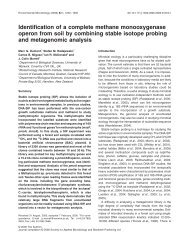Conservation of the vaquita Phocoena sinus - The Department of ...
Conservation of the vaquita Phocoena sinus - The Department of ...
Conservation of the vaquita Phocoena sinus - The Department of ...
You also want an ePaper? Increase the reach of your titles
YUMPU automatically turns print PDFs into web optimized ePapers that Google loves.
200 L. Rojas-Bracho, R. R. Reeves and A. Jaramillo-Legorreta<br />
• Previously estimated bycatch mortality (D’Agrosa et al., 2000) was clearly unsustainable.<br />
• Since <strong>the</strong> time <strong>of</strong> D’Agrosa et al.’s study (1993–94), fishing effort (numbers <strong>of</strong> pangas) has<br />
at least doubled, and <strong>the</strong>refore, <strong>the</strong> rate <strong>of</strong> decline in <strong>the</strong> <strong>vaquita</strong> population has likely<br />
increased.<br />
• <strong>The</strong> current (2004) abundance <strong>the</strong>refore is probably below <strong>the</strong> 1997 level.<br />
<strong>The</strong> Committee recommended that, at a minimum, immediate action should be taken to<br />
prevent any net fishing within <strong>the</strong> core area <strong>of</strong> <strong>vaquita</strong> distribution. In noting that only a<br />
portion <strong>of</strong> <strong>the</strong> core area was contained within <strong>the</strong> Biosphere Reserve (see later; Fig. 2),<br />
participants emphasized <strong>the</strong> importance <strong>of</strong> finding mechanisms not only for eliminating net<br />
fishing in that part <strong>of</strong> <strong>the</strong> Reserve’s buffer zone, but also for extending <strong>the</strong> net ban to a sizeable<br />
area outside <strong>the</strong> Reserve (e.g. establishment <strong>of</strong> a wildlife refuge). For details on this issue, see<br />
<strong>the</strong> sections below on ‘Biosphere Reserve’ and ‘Recent developments with regard to <strong>the</strong> core<br />
area or “polygon” ’. <strong>The</strong> results <strong>of</strong> <strong>the</strong> socio-economic session are reflected in <strong>the</strong> following<br />
section.<br />
Progress on CIRVA recommendations<br />
Important progress has been made on most <strong>of</strong> <strong>the</strong> 10 recommendations from <strong>the</strong> second<br />
CIRVA meeting. However, two <strong>of</strong> <strong>the</strong> more critical ones related to <strong>the</strong> ban on gill nets (items<br />
6 and 8 in <strong>the</strong> above list) have lagged behind: <strong>the</strong> development <strong>of</strong> alternative gear or methods,<br />
and consideration <strong>of</strong> compensation and alternative livelihoods.<br />
After several unsuccessful attempts at developing alternative fishing gear or methods, a<br />
serious effort funded by World Wildlife Fund – US was finally made in <strong>the</strong> summer <strong>of</strong> 2004<br />
to test <strong>the</strong> feasibility <strong>of</strong> using traps (or pots) instead <strong>of</strong> gill nets to catch shrimp (Walsh et al.,<br />
2004). <strong>The</strong> project involved <strong>the</strong> National Marine Mammal Programme (INE) in Ensenada<br />
and <strong>the</strong> Center for Sustainable Resources Marine Institute <strong>of</strong> Memorial University in St<br />
John’s, Newfoundland. Both traps and gill nets were set at four relatively deep (24–31 m) and<br />
cool-water (19–23 °C) sites located well away from shore. Blue and brown shrimp Panaeus<br />
stylirostris and P. californiensis were captured in <strong>the</strong> gill nets, but no shrimp at all were<br />
captured in <strong>the</strong> traps. <strong>The</strong> gillnet catches proved that blue and brown shrimp were present in<br />
<strong>the</strong> area, so <strong>the</strong> failure <strong>of</strong> <strong>the</strong> baited traps to catch any shrimp was interpreted to mean that<br />
a different fishing strategy should be used in future trapping experiments.<br />
An obvious drawback <strong>of</strong> <strong>the</strong> gear trials to date is that <strong>the</strong>y have pertained only to <strong>the</strong><br />
shrimp gillnet fishery and not to <strong>the</strong> gillnet fisheries for finfish. Of course, <strong>the</strong> very large-mesh<br />
gill nets for totoaba and large sharks are now illegal in <strong>the</strong> nor<strong>the</strong>rn Gulf, and <strong>the</strong>refore,<br />
efforts to develop alternatives to <strong>the</strong>m should not be a high priority. Also, in <strong>the</strong> case <strong>of</strong><br />
curvina, <strong>the</strong> normal fishing method is encirclement with gill nets; no reports have been<br />
received <strong>of</strong> <strong>vaquita</strong> by-catch in this type <strong>of</strong> gillnet deployment. Nor has <strong>the</strong> presence <strong>of</strong><br />
<strong>vaquita</strong>s ever been confirmed (ei<strong>the</strong>r visually or acoustically) in <strong>the</strong> delta region where <strong>the</strong><br />
curvina fishery is centred. None<strong>the</strong>less, since <strong>the</strong> nets used to capture curvina are used at<br />
o<strong>the</strong>r seasons to target o<strong>the</strong>r finfish, at which time <strong>the</strong>y are deployed in <strong>the</strong> normal manner<br />
(i.e. passively), it would be beneficial to develop alternative methods for catching curvina.<br />
Despite an agreement announced in August 2000 by <strong>the</strong> Fisheries Commission for El Golfo<br />
de Santa Clara indicating that gill nets with mesh sizes > 6 inches would no longer be used<br />
by fishermen from that community, <strong>the</strong>re is no evidence that this or any o<strong>the</strong>r agreed measure<br />
for eliminating or reducing fishing effort with small- and medium-mesh gill nets has been<br />
implemented. <strong>The</strong>refore, <strong>the</strong> search for alternative ways <strong>of</strong> catching commercially important<br />
finfish (e.g. chano and sierra), sharks and rays must continue (e.g. new trials <strong>of</strong> pots or traps,<br />
© 2006 <strong>The</strong> Authors. Issue compilation © 2006 Mammal Society, Mammal Review, 36, 179–216




